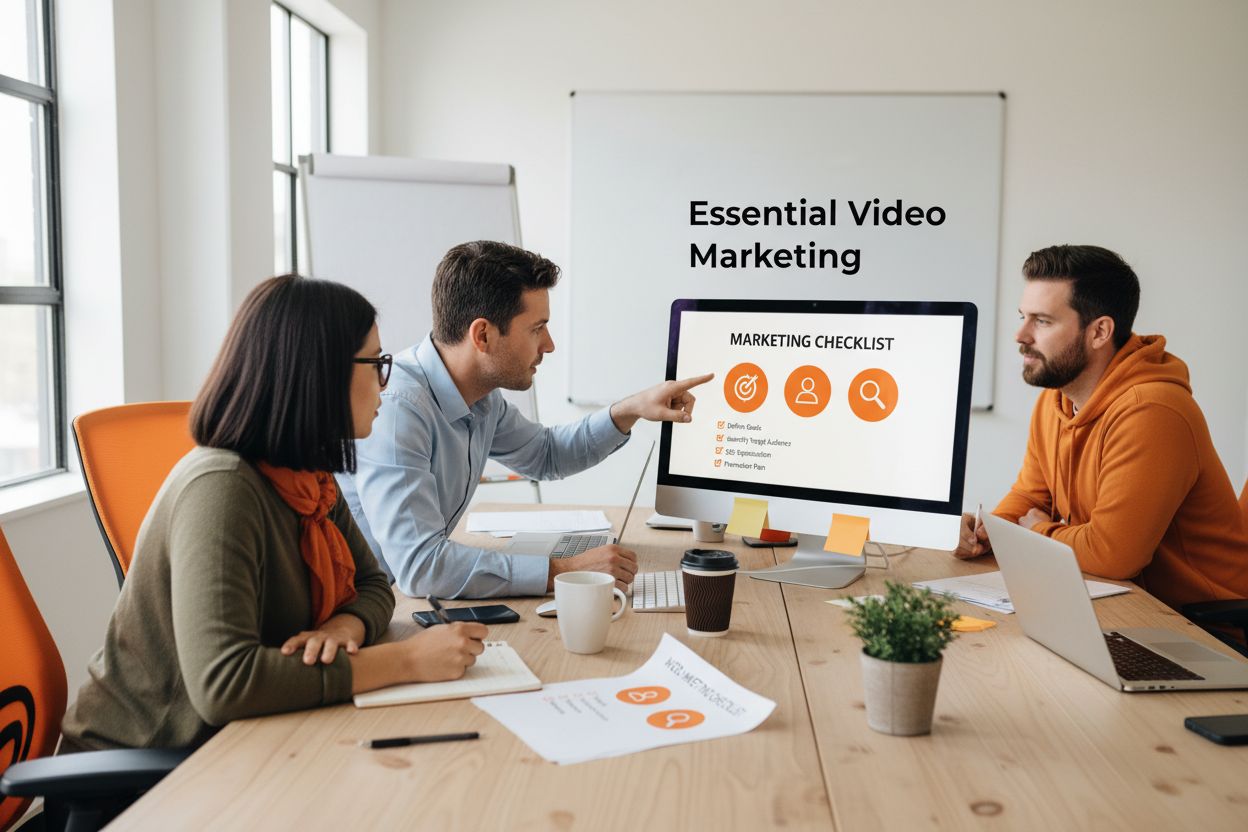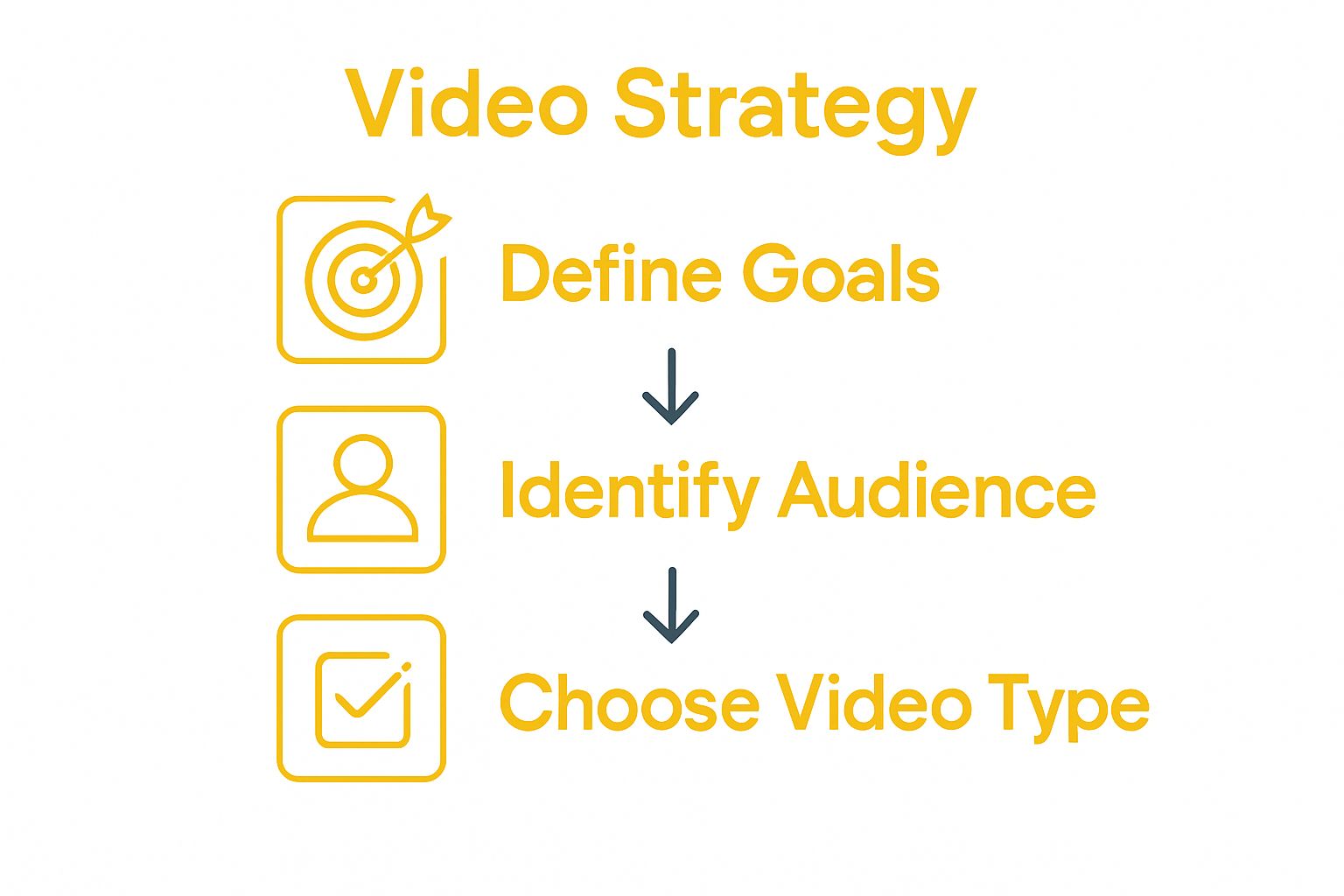Essential Video Marketing Checklist for Local Businesses
- Eddie The Chef

- Oct 12
- 11 min read

Aussie businesses are uploading more video content than ever, chasing better sales and audience loyalty. You’d think with all those hours behind the camera, everyone’s getting it right. But a whopping 88 percent of marketers say their video marketing isn’t tied to clear business goals at all. Setting smart objectives is what actually separates clips that get scrolled past from videos that drive real growth.
Table of Contents
Quick Summary
Key Point | Explanation |
1. Define clear video marketing goals | Establish specific objectives to guide your video strategy, such as brand awareness or sales conversion. |
2. Understand your target audience | Create detailed audience personas by analyzing demographics and psychographics to tailor content effectively. |
3. Choose appropriate video types | Select video formats that align with your marketing goals, like explainer, testimonial, or demonstration videos. |
4. Develop a strategic video content plan | Use a content calendar to schedule videos that resonate with local audiences and address customer needs. |
5. Regularly measure video performance | Employ analytics to monitor engagement metrics, refine strategies based on insights, and adapt to audience preferences. |
Step 1: Define Your Video Marketing Goals
Successful video marketing begins with crystal clear objectives. Think of your video marketing goals as the compass guiding your entire content strategy. Before filming anything, you must understand precisely what you want to achieve. Your goals will shape everything from content style to distribution channels.
Start by asking yourself strategic questions about your business outcomes. Are you aiming to increase brand awareness, generate more leads, showcase product features, or build customer trust? Each goal requires a different video approach.

A brand awareness video will look dramatically different from a product demonstration or customer testimonial.
For regional Australian businesses, video marketing goals typically cluster around several core objectives. Sales conversion remains a primary target, where videos demonstrate product value and solve customer problems. Community connection is another powerful goal specific to local markets. Your videos can highlight your business’s local roots, showcase team personalities, and build genuine relationships with regional customers.
Consider mapping your goals using a structured framework. Specific measurable objectives might include:
Increasing website traffic by 25% within three months
Generating 50 qualified leads per month through video content
Improving social media engagement rates by 40%
Reducing customer service inquiries through informative explainer videos
Learn more about creating a video marketing strategy for regional businesses that aligns with your specific goals. The key is selecting metrics that truly matter to your business growth.
Remember that goal setting is not a one time exercise. Review and adjust your video marketing objectives quarterly. Markets evolve, customer preferences shift, and your strategy should remain flexible. By maintaining clear, measurable goals, you transform video marketing from a creative experiment into a powerful business growth tool.
Step 2: Identify Your Target Audience
Understanding your target audience represents the cornerstone of an effective video marketing strategy. Without precise audience insights, your video content becomes a shot in the dark. Think of audience identification like preparing a gourmet meal - you need to know exactly who will be sitting at the table and what flavours they crave.
Start by developing comprehensive audience personas that go beyond basic demographics. Regional Australian businesses must dig deeper than surface level characteristics. Consider psychographic elements like values, interests, pain points, and communication preferences. A tradesperson in Gippsland will respond differently to video content compared to a professional in Melbourne’s financial sector.
Gather audience intelligence through multiple channels. Customer surveys, social media analytics, and direct conversations provide rich insights. Examine your existing client database to understand common characteristics. Look for patterns in age groups, professional backgrounds, spending habits, and digital engagement levels. Website analytics can reveal critical information about who currently interacts with your online presence.
Consider creating audience segments specific to your business type. For example:
Professional services might target decision makers aged 35-55
Hospitality businesses could focus on local weekend travellers
Trade businesses might aim at homeowners and property managers
Medical practices could segment by age groups and specific health interests
Understand why video marketing matters for different business types when tailoring your approach. Your audience research should inform not just who you target, but how you communicate with them.
Validate your audience personas through ongoing feedback. Watch how different demographic groups interact with your initial video content. Be prepared to refine your understanding continuously. Audience preferences evolve, and successful video marketing demands constant adaptation and keen observation.
Step 3: Choose the Right Video Types
Selecting appropriate video types transforms your marketing from generic content to targeted communication. Video isn’t a one size fits all strategy. Each video format serves distinct purposes, acting like different kitchen utensils designed for specific culinary tasks.
For regional Australian businesses, video types must align precisely with audience needs and marketing objectives. Explainer videos work brilliantly for complex services, breaking down technical information into digestible visual narratives. These videos help potential customers understand your unique value proposition quickly and engagingly.
Customer testimonial videos represent powerful social proof, especially in tight knit regional communities. When local customers see genuine experiences from their peers, trust builds rapidly. Authentic storytelling becomes your most persuasive marketing tool. A tradie sharing their successful project or a local cafe owner discussing community impact can resonate more powerfully than traditional advertising.
Consider matching video types to specific business goals:
Product demonstration videos for technical or innovative offerings
Behind the scenes content showcasing business personality
Training and educational videos for service based businesses
Customer journey and success story documentaries
Quick social media clips for immediate engagement
Discover step by step guidance on creating a comprehensive video marketing strategy tailored to your specific business needs. Your video type selection should feel like a strategic conversation with your ideal customer.
Remember that video quality matters more than fancy production. Regional businesses can create compelling content using smartphones and basic editing tools. Focus on clear messaging, genuine representation, and solving customer problems. Authenticity trumps polished perfection every time in video marketing.
The following table compares common video types that local businesses can use, matching each to its ideal purpose, typical audience, and a practical tip for maximising effectiveness.
Video Type | Ideal Purpose | Target Audience | Practical Tip |
Explainer Video | Simplify complex services | New or curious customers | Keep it under 2 minutes |
Customer Testimonial | Build trust and social proof | Local community, potential leads | Use real clients and authentic stories |
Product Demonstration | Showcase technical products/features | Prospects requiring detail | Focus on benefits, not just features |
Behind the Scenes | Humanise business, show personality | Loyal followers, locals | Highlight your team and unique culture |
Training/Educational Content | Address common questions, educate | Current customers, prospects | Break content into easy-to-follow steps |
Customer Journey Documentary | Tell in-depth success stories | High-value leads, stakeholders | Feature results, not just process |
Social Media Clip | Drive quick engagement and awareness | Wider digital audience | Optimise for vertical/mobile viewing |
Step 4: Plan Your Video Content Strategy
A robust video content strategy transforms random content creation into a purposeful marketing engine. Think of your strategy as a detailed roadmap that guides every video production decision, ensuring each piece of content serves a specific business objective.
Content calendaring becomes your strategic foundation. Regional businesses must plan content that resonates with local audiences while maintaining consistent messaging. Map out your video topics quarterly, aligning them with seasonal trends, business cycles, and community events specific to your market. A local automotive workshop might create maintenance tip videos before winter, while a coastal restaurant could develop tourism focused content during peak travel seasons.
Develop a balanced content mix that addresses different stages of customer journey. Some videos should attract new audiences, while others nurture existing customer relationships. Consider creating content that educates, entertains, and solves specific customer problems. Your strategy should include variety - from quick social media snippets to more comprehensive explainer videos.
Consider structuring your content plan around key principles:
Maintain consistent brand voice across all video formats
Create content that answers common customer questions- Develop videos with clear call to action elements
Plan for cross platform distribution
Ensure visual and messaging consistency
Explore current video marketing statistics to validate your strategic approach. These insights can help refine your content planning and understand market trends.
Successful video strategies require flexibility. Monitor performance metrics regularly and be prepared to adjust your approach. What works in one quarter might need refinement in the next. Your content strategy is a living document that evolves with your business and audience needs. Think of it as a dynamic recipe that you continually taste and season to perfection.
Step 5: Optimize Your Videos for SEO
Search engine optimization transforms your video content from invisible to discoverable. For regional Australian businesses, SEO represents the digital signpost that guides potential customers directly to your content. Effective video SEO goes beyond basic keyword insertion - it requires strategic thinking and meticulous implementation.
Metadata optimization becomes your primary weapon in the SEO battle. Your video titles, descriptions, and tags must speak both to search algorithms and human curiosity. Craft titles that are descriptive, include primary keywords, and communicate immediate value. Regional businesses should incorporate location specific terms that reflect local search patterns. A plumber in Gippsland might use a title like “Emergency Pipe Repair Techniques for Gippsland Homeowners” instead of a generic “Plumbing Tips.”
Transcriptions and closed captions offer powerful SEO opportunities most businesses overlook. Search engines can crawl these text elements, providing additional context about your video content. This approach not only improves search rankings but also makes your content more accessible to viewers with hearing challenges. Think of transcriptions as hidden text highways that guide search engines directly to your content.
Consider implementing these strategic SEO elements:
Use precise, keyword rich video descriptions
Create custom video thumbnails that attract clicks
Tag videos with relevant, specific keywords
Include location and industry specific search terms
Link videos back to your website
Explore our comprehensive guide to YouTube SEO for advanced optimization techniques. Your goal is making videos that not only look good but get found by the right audience.

Remember that SEO is an ongoing process. Regularly review your video performance, track search rankings, and be prepared to refine your approach. The digital landscape evolves continuously, and your SEO strategy must remain as dynamic and adaptable as your business itself.
Step 6: Measure and Analyze Video Performance
Measuring video performance transforms raw data into actionable business intelligence. For regional Australian businesses, analytics provide a crystal clear window into audience engagement, helping you refine your video marketing strategy with precision and confidence.
Performance tracking requires understanding key metrics beyond simple view counts. Engagement rates, watch time, click through rates, and conversion metrics tell a more comprehensive story about your video content’s effectiveness. A 30 second video with high retention rates might be more valuable than a 5 minute video that viewers abandon after just 10 seconds. Local businesses must look deeper than surface level numbers to understand true audience connection.
Utilize platform specific analytics tools like YouTube Studio, Facebook Insights, and Google Analytics to gather comprehensive data. Each platform offers unique insights into audience behavior. Pay special attention to demographic information, viewing patterns, and how viewers interact with your content. Are they watching full videos? Clicking through to your website? Sharing with others? These nuanced interactions reveal more about content performance than raw view statistics.
Consider tracking these critical performance indicators:
Total video views and view duration
Audience retention percentages
Click through rates to website
Social media shares and comments
Conversion rates from video viewers
Geographic distribution of viewers
Learn more about understanding video marketing performance to refine your approach. Treat your analytics dashboard like a business compass, guiding strategic content decisions.
Remember that performance analysis is not a one time task. Schedule monthly or quarterly reviews of your video metrics. Look for trends, celebrate successes, and use insights to continuously improve your video marketing strategy. Your data tells a story - learn to read it fluently.
This checklist table summarises essential actions and completion tips for each step in the video marketing process, helping you keep track and ensure nothing is missed.
Step | Completion Criteria | How to Check Off |
Define Video Marketing Goals | Goals are SMART and measured quarterly | Document specific metrics and timeframes |
Identify Target Audience | Personas cover demographics & psychographics | Validate with customer insights |
Choose Appropriate Video Types | Video formats align with business objectives | Match video purpose to audience needs |
Plan Content Strategy | Quarterly video calendar reflects local events | Review calendar for business alignment |
Optimise for SEO | Each video uses keywords, titles, transcripts | Spot check video uploads for SEO fields |
Measure and Analyse Performance | Monthly/quarterly analytics reviews completed | Log and review trends in key metrics |
Turn Your Video Marketing Checklist Into Real Business Growth
Local business owners face real struggles with video marketing. You want measurable results, not just more noise online. The article breaks down the essentials—goal setting, audience understanding, choosing the right video types, and using SEO. But putting this checklist into action can feel overwhelming for a regional business juggling daily pressures. If you have ever wondered where to start or how to get your video marketing working for you, you are not alone. The challenge is moving from checklists to real actions that boost brand visibility, win local customers, and actually grow your business.

Ready to see your checklist drive results? At Marketing Recipes Australia, we specialise in helping regional businesses like yours bridge the gap between strategy and success. Our kitchen-inspired approach blends hands-on video production with digital marketing that hits local targets. Explore how our bespoke video marketing strategies work for your industry or learn why tailored video marketing delivers for local businesses. There has never been a better time to put the essential steps from your checklist into action. Visit Marketing Recipes Australia now and connect with our team for a free, no-obligation chat about levelling up your video marketing.
Frequently Asked Questions
What video marketing goals should local businesses focus on?
Successful video marketing for local businesses often targets goals like increasing brand awareness, generating leads, or enhancing customer trust. Start by defining what you want to achieve and consider metrics such as increasing web traffic by 25% within three months to steer your strategy.
How can I identify my target audience for video marketing?
To effectively identify your target audience, develop detailed audience personas that include demographics, interests, and pain points. Gather insights through customer surveys and social media analytics to ensure your video content resonates with the right viewers.
What types of video content work best for local businesses?
Local businesses should consider video formats like explainer videos for complex services, customer testimonials for social proof, and product demonstrations to showcase offerings effectively. Choose formats that align with specific marketing goals, such as creating training videos that address common customer questions.
How do I plan a video content strategy?
A solid video content strategy involves creating a content calendar that aligns video topics with local events and business cycles. Outline what type of videos you will create each month, ensuring a balanced mix that caters to different stages of the customer journey.
What steps can I take to optimize my videos for SEO?
To optimize your videos for SEO, focus on crafting descriptive titles, using relevant keywords in descriptions, and adding transcriptions for accessibility. Implement these strategies to improve your visibility in search results and attract more viewers.
How do I measure the performance of my video content?
Measure video performance by tracking metrics like audience retention rates, click-through rates, and overall engagement on platforms. Regularly review these metrics at least once a month to identify trends and make data-driven adjustments to your video marketing strategy.
Recommended
Comments